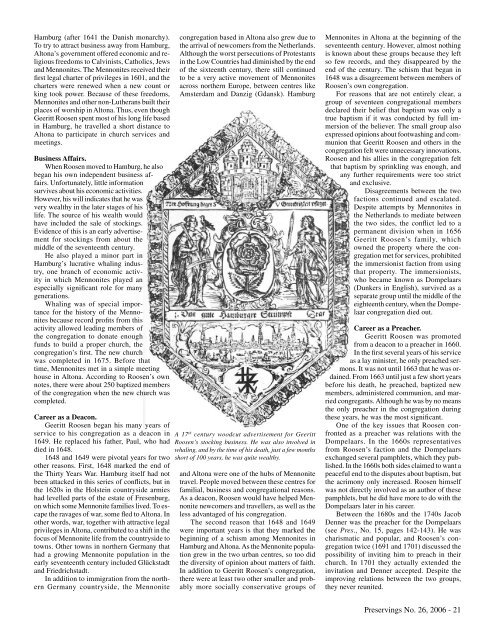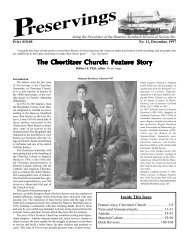Preservings $20 Issue No. 26, 2006 - Home at Plett Foundation
Preservings $20 Issue No. 26, 2006 - Home at Plett Foundation
Preservings $20 Issue No. 26, 2006 - Home at Plett Foundation
Create successful ePaper yourself
Turn your PDF publications into a flip-book with our unique Google optimized e-Paper software.
Hamburg (after 1641 the Danish monarchy).<br />
To try to <strong>at</strong>tract business away from Hamburg,<br />
Altona’s government offered economic and religious<br />
freedoms to Calvinists, C<strong>at</strong>holics, Jews<br />
and Mennonites. The Mennonites received their<br />
first legal charter of privileges in 1601, and the<br />
charters were renewed when a new count or<br />
king took power. Because of these freedoms,<br />
Mennonites and other non-Lutherans built their<br />
places of worship in Altona. Thus, even though<br />
Geeritt Roosen spent most of his long life based<br />
in Hamburg, he travelled a short distance to<br />
Altona to particip<strong>at</strong>e in church services and<br />
meetings.<br />
Business Affairs.<br />
When Roosen moved to Hamburg, he also<br />
began his own independent business affairs.<br />
Unfortun<strong>at</strong>ely, little inform<strong>at</strong>ion<br />
survives about his economic activities.<br />
However, his will indic<strong>at</strong>es th<strong>at</strong> he was<br />
very wealthy in the l<strong>at</strong>er stages of his<br />
life. The source of his wealth would<br />
have included the sale of stockings.<br />
Evidence of this is an early advertisement<br />
for stockings from about the<br />
middle of the seventeenth century.<br />
He also played a minor part in<br />
Hamburg’s lucr<strong>at</strong>ive whaling industry,<br />
one branch of economic activity<br />
in which Mennonites played an<br />
especially significant role for many<br />
gener<strong>at</strong>ions.<br />
Whaling was of special importance<br />
for the history of the Mennonites<br />
because record profits from this<br />
activity allowed leading members of<br />
the congreg<strong>at</strong>ion to don<strong>at</strong>e enough<br />
funds to build a proper church, the<br />
congreg<strong>at</strong>ion’s first. The new church<br />
was completed in 1675. Before th<strong>at</strong><br />
time, Mennonites met in a simple meeting<br />
house in Altona. According to Roosen’s own<br />
notes, there were about 250 baptized members<br />
of the congreg<strong>at</strong>ion when the new church was<br />
completed.<br />
Career as a Deacon.<br />
Geeritt Roosen began his many years of<br />
service to his congreg<strong>at</strong>ion as a deacon in<br />
1649. He replaced his f<strong>at</strong>her, Paul, who had<br />
died in 1648.<br />
1648 and 1649 were pivotal years for two<br />
other reasons. First, 1648 marked the end of<br />
the Thirty Years War. Hamburg itself had not<br />
been <strong>at</strong>tacked in this series of conflicts, but in<br />
the 1620s in the Holstein countryside armies<br />
had levelled parts of the est<strong>at</strong>e of Fresenburg,<br />
on which some Mennonite families lived. To escape<br />
the ravages of war, some fled to Altona. In<br />
other words, war, together with <strong>at</strong>tractive legal<br />
privileges in Altona, contributed to a shift in the<br />
focus of Mennonite life from the countryside to<br />
towns. Other towns in northern Germany th<strong>at</strong><br />
had a growing Mennonite popul<strong>at</strong>ion in the<br />
early seventeenth century included Glückstadt<br />
and Friedrichstadt.<br />
In addition to immigr<strong>at</strong>ion from the northern<br />
Germany countryside, the Mennonite<br />
congreg<strong>at</strong>ion based in Altona also grew due to<br />
the arrival of newcomers from the Netherlands.<br />
Although the worst persecutions of Protestants<br />
in the Low Countries had diminished by the end<br />
of the sixteenth century, there still continued<br />
to be a very active movement of Mennonites<br />
across northern Europe, between centres like<br />
Amsterdam and Danzig (Gdansk). Hamburg<br />
A 17 th century woodcut advertisement for Geeritt<br />
Roosen’s stocking business. He was also involved in<br />
whaling, and by the time of his de<strong>at</strong>h, just a few months<br />
short of 100 years, he was quite wealthy.<br />
and Altona were one of the hubs of Mennonite<br />
travel. People moved between these centres for<br />
familial, business and congreg<strong>at</strong>ional reasons.<br />
As a deacon, Roosen would have helped Mennonite<br />
newcomers and travellers, as well as the<br />
less advantaged of his congreg<strong>at</strong>ion.<br />
The second reason th<strong>at</strong> 1648 and 1649<br />
were important years is th<strong>at</strong> they marked the<br />
beginning of a schism among Mennonites in<br />
Hamburg and Altona. As the Mennonite popul<strong>at</strong>ion<br />
grew in the two urban centres, so too did<br />
the diversity of opinion about m<strong>at</strong>ters of faith.<br />
In addition to Geeritt Roosen’s congreg<strong>at</strong>ion,<br />
there were <strong>at</strong> least two other smaller and probably<br />
more socially conserv<strong>at</strong>ive groups of<br />
Mennonites in Altona <strong>at</strong> the beginning of the<br />
seventeenth century. However, almost nothing<br />
is known about these groups because they left<br />
so few records, and they disappeared by the<br />
end of the century. The schism th<strong>at</strong> began in<br />
1648 was a disagreement between members of<br />
Roosen’s own congreg<strong>at</strong>ion.<br />
For reasons th<strong>at</strong> are not entirely clear, a<br />
group of seventeen congreg<strong>at</strong>ional members<br />
declared their belief th<strong>at</strong> baptism was only a<br />
true baptism if it was conducted by full immersion<br />
of the believer. The small group also<br />
expressed opinions about footwashing and communion<br />
th<strong>at</strong> Geeritt Roosen and others in the<br />
congreg<strong>at</strong>ion felt were unnecessary innov<strong>at</strong>ions.<br />
Roosen and his allies in the congreg<strong>at</strong>ion felt<br />
th<strong>at</strong> baptism by sprinkling was enough, and<br />
any further requirements were too strict<br />
and exclusive.<br />
Disagreements between the two<br />
factions continued and escal<strong>at</strong>ed.<br />
Despite <strong>at</strong>tempts by Mennonites in<br />
the Netherlands to medi<strong>at</strong>e between<br />
the two sides, the conflict led to a<br />
permanent division when in 1656<br />
Geeritt Roosen’s family, which<br />
owned the property where the congreg<strong>at</strong>ion<br />
met for services, prohibited<br />
the immersionist faction from using<br />
th<strong>at</strong> property. The immersionists,<br />
who became known as Dompelaars<br />
(Dunkers in English), survived as a<br />
separ<strong>at</strong>e group until the middle of the<br />
eighteenth century, when the Dompelaar<br />
congreg<strong>at</strong>ion died out.<br />
Career as a Preacher.<br />
Geeritt Roosen was promoted<br />
from a deacon to a preacher in 1660.<br />
In the first several years of his service<br />
as a lay minister, he only preached sermons.<br />
It was not until 1663 th<strong>at</strong> he was ordained.<br />
From 1663 until just a few short years<br />
before his de<strong>at</strong>h, he preached, baptized new<br />
members, administered communion, and married<br />
congregants. Although he was by no means<br />
the only preacher in the congreg<strong>at</strong>ion during<br />
these years, he was the most significant.<br />
One of the key issues th<strong>at</strong> Roosen confronted<br />
as a preacher was rel<strong>at</strong>ions with the<br />
Dompelaars. In the 1660s represent<strong>at</strong>ives<br />
from Roosen’s faction and the Dompelaars<br />
exchanged several pamphlets, which they published.<br />
In the 1660s both sides claimed to want a<br />
peaceful end to the disputes about baptism, but<br />
the acrimony only increased. Roosen himself<br />
was not directly involved as an author of these<br />
pamphlets, but he did have more to do with the<br />
Dompelaars l<strong>at</strong>er in his career.<br />
Between the 1680s and the 1740s Jacob<br />
Denner was the preacher for the Dompelaars<br />
(see Pres., <strong>No</strong>. 15, pages 142-143). He was<br />
charism<strong>at</strong>ic and popular, and Roosen’s congreg<strong>at</strong>ion<br />
twice (1691 and 1701) discussed the<br />
possibility of inviting him to preach in their<br />
church. In 1701 they actually extended the<br />
invit<strong>at</strong>ion and Denner accepted. Despite the<br />
improving rel<strong>at</strong>ions between the two groups,<br />
they never reunited.<br />
<strong>Preservings</strong> <strong>No</strong>. <strong>26</strong>, <strong>2006</strong> - 21
















